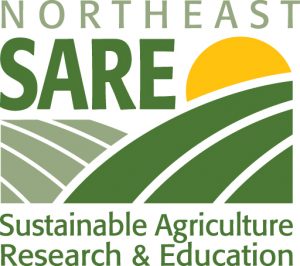Buckwheat Hay for Dairy Feed
John and Christine O’Meara grew buckwheat hay on their farm to transition an abandoned field into cropland and enhance their milk production.
SARE GRANT FNE10-698
Written by Anne de Ferron, Graduate Student, French National Agronomic School of Toulouse, France.
O’Meara Family Farm
John and Christine O’Meara farm a total of 150 acres, all organic certified by MOFGA. They manage a 40 cows herd, 14 of which were milked during the 2012 season. Their organic yogurts and cheeses are marketed through a cooperative and two local farmers markets and some of the calves are also sold as cow pets.
The O’Mearas started this operation in 2004, after they moved from Massachusetts. They previously owned a 20-acres dairy farm, and decided to pack their family and cows and they moved by the Canadian border, where they could farm more land. They settled in Aroostook County, in the small city of New Sweden, Maine. At this time, most of their land was out of production for 10 years or more.
The O’Mearas’ guiding principle is to run a low-input agricultural system that is both environmentally and economically sustainable. They produce their own dairy feed and prioritize their animals’ welfare. John and Christine chose to breed mainly Dexters because of their hardiness. They can handle tough weather conditions and maintain a reasonable milk production even if fed with medium quality feed.
The SARE grant
John O’Meara had two prior SARE grants, one studying the efficiency of smoke against varroa mites in hives and the other investigating silvopasture in the Northeast. For this third grant on buckwheat hay, John said, “the idea was to get a quality feed that was easy to grow in a short season.” Moreover, he felt buckwheat could improve soil quality and help renovate abandoned land for crop production.
John planted 10 acres to buckwheat hay in the spring of 2010. The fields had been out of production for between 4 and 15 years. Soil tests indicated low available nitrogen and marginal soil quality for crop production. John harvested buckwheat hay in August and stored it until the pasture ran out in October.
John fed half of the dairy cows 15 pounds of buckwheat hay per day (Group A), while the other half (Group B) received the same amount of good quality first-cut hay. Both groups also were fed additional first-cut hay as needed. John followed this practice and collected data during the milking season, in the fall of 2010 and spring of 2011. Groups A and B were fed with the same amount of regular grass hay over the winter.
The results
After a milking season, no significant differences were observed and both groups continued to produce about the same amount of milk.
Buckwheat hay yield and quality were reasonable but below John’s expectations. Average crude protein was 6.8% (dry matter basis), the relative feed value was 88, and the yield was 60 bales per acre. Raking and harvesting the hay were hard on the equipment because the biomass production was low. As well, the buckwheat hay took a long time to dry, 5 hot and dry days as compared to 2 days for regular hay.
However, the cows loved buckwheat hay, and John felt yields were reasonable for a field that was out of production for years: “Buckwheat is really good in a rotation. It will smother weeds and bring up nutrients from pretty deep down,” John says. It also helped reducing soil compaction and helped turn an abandoned fallow into productive cropland: “I had a really decent winter wheat after it, without any tillage.”
Summary
The SARE grant funded labor, buckwheat seeds, and soil and hay tests for the project. Even though making buckwheat hay and tracking milk production were time-consuming, the O’Mearas felt that it was well worth doing. Indeed, they say the project has been a great learning experience. John has continued to grow buckwheat in his rotations to improve soil quality, but he uses it for grain rather than hay. However, if one is set on buckwheat hay, he recommends using a mower conditioner or growing buckwheat with rye or oat to shorten drying time. Growing buckwheat for silage could be a solution, too.
Overall, John O’Meara is pleased with the project’s outcomes. He established that buckwheat hay is an acceptable dairy feed, is beneficial in a rotation, and in terms of improving the soil, he concluded, “I would definitely grow it again.”
For more information on the project see the SARE project report.
For more information about Northeast SARE Farmer Grants see the NE-SARE website.
